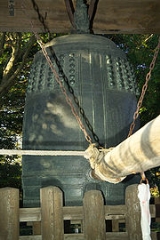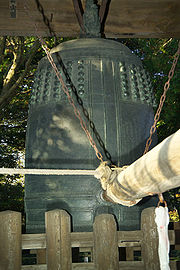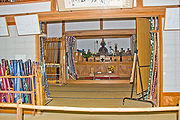
Engaku-ji
Encyclopedia



Enryaku-ji
thumb|300px|Konpon Chū-dō , Enryaku-ji's main hall is a Tendai monastery located on Mount Hiei in Ōtsu, overlooking Kyoto. It was founded during the early Heian period. The temple complex was established by Saichō , also known as Dengyō Daishi, who introduced the Tendai sect of Mahayana Buddhism...
in Kyoto
Kyoto
is a city in the central part of the island of Honshū, Japan. It has a population close to 1.5 million. Formerly the imperial capital of Japan, it is now the capital of Kyoto Prefecture, as well as a major part of the Osaka-Kobe-Kyoto metropolitan area.-History:...
.
, or Engaku-ji (円覚寺), is one of the most important Zen Buddhist temple
Temple
A temple is a structure reserved for religious or spiritual activities, such as prayer and sacrifice, or analogous rites. A templum constituted a sacred precinct as defined by a priest, or augur. It has the same root as the word "template," a plan in preparation of the building that was marked out...
complexes in Japan
Japan
Japan is an island nation in East Asia. Located in the Pacific Ocean, it lies to the east of the Sea of Japan, China, North Korea, South Korea and Russia, stretching from the Sea of Okhotsk in the north to the East China Sea and Taiwan in the south...
and is ranked second among Kamakura's Five Mountains
Five Mountain System
The system, more commonly called simply Five Mountain System, was a network of state-sponsored Zen Buddhist temples created in China during the Southern Song Dynasty . The term "mountain" in this context means "temple" or "monastery", and was adopted because many monasteries were built on isolated...
. It is situated in the city
Cities of Japan
||A is a local administrative unit in Japan. Cities are ranked on the same level as and , with the difference that they are not a component of...
of Kamakura
Kamakura, Kanagawa
is a city located in Kanagawa Prefecture, Japan, about south-south-west of Tokyo. It used to be also called .Although Kamakura proper is today rather small, it is often described in history books as a former de facto capital of Japan as the seat of the Shogunate and of the Regency during the...
, in Kanagawa prefecture
Kanagawa Prefecture
is a prefecture located in the southern Kantō region of Japan. The capital is Yokohama. Kanagawa is part of the Greater Tokyo Area.-History:The prefecture has some archaeological sites going back to the Jōmon period...
to the south of Tokyo
Tokyo
, ; officially , is one of the 47 prefectures of Japan. Tokyo is the capital of Japan, the center of the Greater Tokyo Area, and the largest metropolitan area of Japan. It is the seat of the Japanese government and the Imperial Palace, and the home of the Japanese Imperial Family...
. It is very close to the Kita-Kamakura railway station on the Tokyo to Yokosuka line, and indeed the railway tracks cut across the formal entrance to the temple compound, which (showing Chinese
China
Chinese civilization may refer to:* China for more general discussion of the country.* Chinese culture* Greater China, the transnational community of ethnic Chinese.* History of China* Sinosphere, the area historically affected by Chinese culture...
influence) is by a path beside a pond which is crossed by a small bridge.
The temple was founded in 1282 by a Chinese Zen monk
Monk
A monk is a person who practices religious asceticism, living either alone or with any number of monks, while always maintaining some degree of physical separation from those not sharing the same purpose...
at the request of the then ruler of Japan, the regent
Regent
A regent, from the Latin regens "one who reigns", is a person selected to act as head of state because the ruler is a minor, not present, or debilitated. Currently there are only two ruling Regencies in the world, sovereign Liechtenstein and the Malaysian constitutive state of Terengganu...
Hōjō Tokimune
Hojo Tokimune
of the Hōjō clan was the eighth shikken of the Kamakura shogunate , known for leading the Japanese forces against the invasion of the Mongols and for spreading Zen Buddhism and by extension Bushido among the warrior class.- Life :Born as the eldest son of the regent and Tokuso Tokiyori of the...
after he had repelled a Mongolia
Mongolia
Mongolia is a landlocked country in East and Central Asia. It is bordered by Russia to the north and China to the south, east and west. Although Mongolia does not share a border with Kazakhstan, its western-most point is only from Kazakhstan's eastern tip. Ulan Bator, the capital and largest...
n invasion in the period 1274 to 1281. Tokimune had a long-standing commitment to Zen and the temple was intended to honour those of both sides who died in the war, as well as serving as a centre from which the influence of Zen could be spread. According to the records of the time, when building work started a copy of the Sutra of Perfect Enlightenment
Sutra of Perfect Enlightenment
The Sutra of Perfect Enlightenment or Complete Enlightenment is a Mahāyāna Buddhist sūtra highly esteemed by both the Huayan and Zen schools....
(in Japanese, engaku-kyō 円覚経) was dug out of the hillside in a stone chest during the initial building works, giving its name to the temple.
The fortunes of the temple have waxed and waned over the centuries. Its present form is owed to the Zen priest
Priest
A priest is a person authorized to perform the sacred rites of a religion, especially as a mediatory agent between humans and deities. They also have the authority or power to administer religious rites; in particular, rites of sacrifice to, and propitiation of, a deity or deities...
Seisetsu, who reconstructed and consolidated it towards the end of the Edo
Edo
, also romanized as Yedo or Yeddo, is the former name of the Japanese capital Tokyo, and was the seat of power for the Tokugawa shogunate which ruled Japan from 1603 to 1868...
era. In the Meiji
Meiji period
The , also known as the Meiji era, is a Japanese era which extended from September 1868 through July 1912. This period represents the first half of the Empire of Japan.- Meiji Restoration and the emperor :...
era, Engaku-ji became the chief centre for Zen instruction in the Kantō region; Kosen Roshi
Kosho Uchiyama
was a Sōtō priest, origami master, and the former abbot of Antaiji near Kyoto, Japan.The author of more than twenty books on Zen Buddhism and origami—of which Opening the Hand of Thought: Foundations of Zen Buddhist Practice is best-known—Uchiyama graduated from Waseda University with a masters...
and Soyen Shaku
Soyen Shaku
Soyen Shaku was the first Zen Buddhist master to teach in the United States. He was a Roshi of the Rinzai school and was abbot of both Kencho-ji and Engaku-ji temples in Kamakura, Japan...
were successively abbot
Abbot
The word abbot, meaning father, is a title given to the head of a monastery in various traditions, including Christianity. The office may also be given as an honorary title to a clergyman who is not actually the head of a monastery...
s in this period, and Daisetz Teitaro Suzuki
Daisetz Teitaro Suzuki
Daisetsu Teitaro Suzuki was a Japanese author of books and essays on Buddhism, Zen and Shin that were instrumental in spreading interest in both Zen and Shin to the West. Suzuki was also a prolific translator of Chinese, Japanese, and Sanskrit literature...
was a student under them. Zazen
Zazen
In Zen Buddhism, zazen is a meditative discipline practitioners perform to calm the body and the mind, and be able to concentrate enough to experience insight into the nature of existence and thereby gain enlightenment .- Significance :Zazen is considered the heart of Zen Buddhist practice...
courses are still held in the temple.
Fire has damaged many of the buildings at different times, and the dates given below refer to the building of the structures currently seen. From the entrance, the buildings of the temple rise up a wooded hillside, with the major buildings in a straight line in the Chinese style; the austere buildings and the trees blending in a satisfying overall composition. There are altogether 18 temples on the site. Among the buildings and other monuments are:
- the two-storied main gate, or , with framed calligraphy by the Emperor FushimiEmperor FushimiEmperor Fushimi was the 92nd emperor of Japan, according to the traditional order of succession...
; - a large modern Butsu-den (仏殿; main hall; 1964)
- Shari-den (舎利殿; reliquary hall), built in the sixteenth century in the style of the Chinese Song dynastySong DynastyThe Song Dynasty was a ruling dynasty in China between 960 and 1279; it succeeded the Five Dynasties and Ten Kingdoms Period, and was followed by the Yuan Dynasty. It was the first government in world history to issue banknotes or paper money, and the first Chinese government to establish a...
, which houses what is claimed to be a tooth of the Buddha; - the thatched Butsunichi-an (仏日庵) which is the burial site of Hōjō Tokimune;
- Ōbai-in (黄梅院), a small thatched temple containing a statue of Kannon; (1301), at 2.5 metres tall the largest of all the many temple bells of Kamakura.
Of these, the Shari-den and the Great Bell have been designated as National Treasures
National treasures of Japan
National Treasures are the most precious of Japan's Tangible Cultural Properties, as determined and designated by the Agency for Cultural Affairs...
.
There is an admission fee for visitors to enter the temple complex, and additional similar charges to enter a few of the buildings. Booths selling tourist items are located near the entrance, below the San-mon, and there are refreshment facilities in the garden of the Shari-den and at the platform where the Great Bell is located, from where there are extensive views across the valley to other temple complexes in the Kita-Kamakura neighbourhood, such as Jōchi-ji
Jochi-ji
is a Buddhist Zen temple in Kita-Kamakura, Kanagawa Prefecture, Japan. It belongs to the Engaku-ji school of the Rinzai sect and is ranked fourth among Kamakura's Five Mountains...
and Tōkei-ji
Tokei-ji
, also known as or ), is a Buddhist temple and a former nunnery, the only survivor of a network of five nunneries called , in the city of Kamakura in Kanagawa Prefecture, Japan. It is part of the Rinzai school of Zen's Engaku-ji branch, and was opened by Hōjō Sadatoki in 1285. It is best known as...
.
See also
- For an explanation of terms concerning Japanese Buddhism, Japanese Buddhist art, and Japanese Buddhist temple architecture, see the Glossary of Japanese BuddhismGlossary of Japanese BuddhismThis is the glossary of Japanese Buddhism, including major terms the casual reader might find useful in understanding articles on the subject. Words followed by an asterisk are illustrated by an image in one of the photo galleries...
. - List of National Treasures of Japan (crafts-others)
External links
- Official website
- Engakuji Temple at Kamakura: History & Historic Sites
- Engakuji (overview)
- Donryu Jizo Great Bodhisattva - Monument near front entrance of Engaku-ji.

